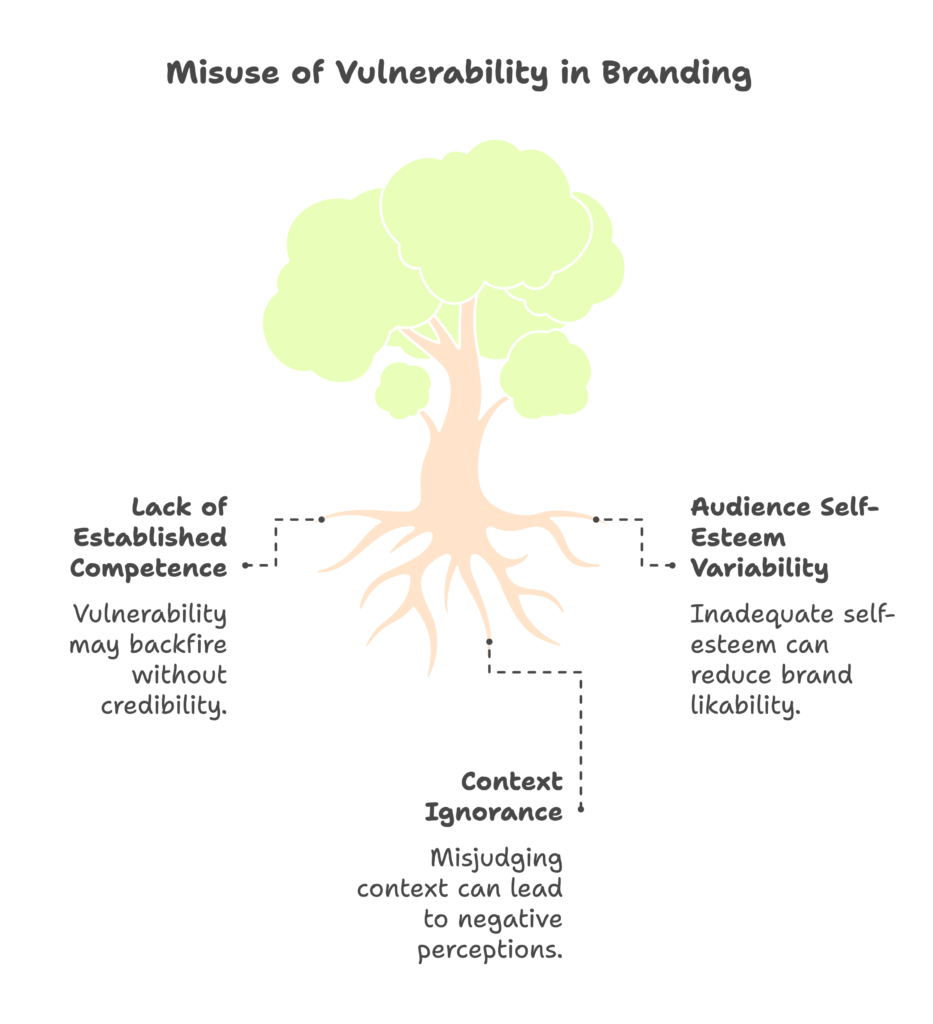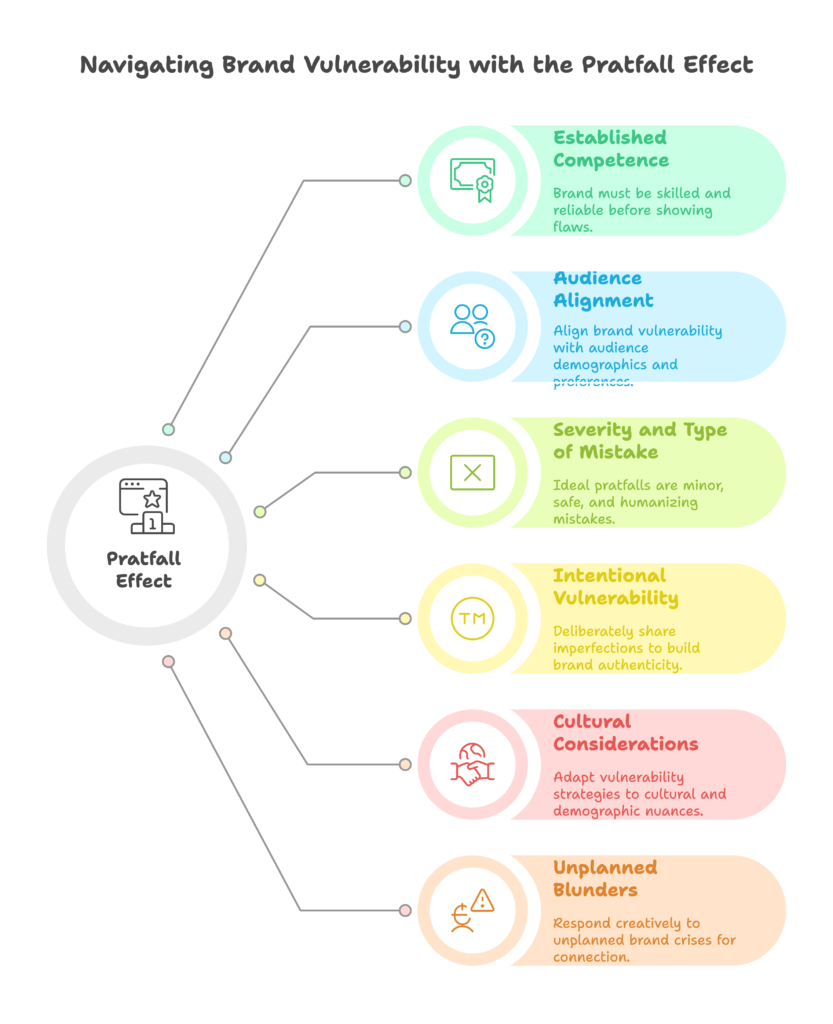Have you ever found yourself more drawn to a brand after they made a mistake and handled it well? Maybe it was that time KFC ran out of chicken (yes, a chicken restaurant without chicken!) and responded with a brilliant “FCK” apology campaign. Or perhaps it was when Slack openly shared updates during an outage, making you feel like a human was actually behind their operations.
If so, you’ve experienced the Pratfall Effect in action—a fascinating psychological phenomenon where brands become more likable after showing vulnerability, not less.
In a world overflowing with AI-perfect marketing and polished brand personas, audiences are craving authenticity. The numbers don’t lie: 86% of consumers cite authenticity as key to brand loyalty. But how can you effectively tap into this powerful psychological principle without coming across as manipulative or damaging your brand’s reputation?
In this article, you’ll learn:
- What the Pratfall Effect is and why it matters in today’s marketing landscape
- The psychological science behind why vulnerability can boost brand appeal
- How to effectively use “strategic imperfection” in your marketing
- Real-world case studies of brands that nailed it (and those that failed spectacularly)
- Practical ways to measure the impact of embracing imperfection
- Future trends in authentic brand positioning
Ready to discover how the right kind of mistakes might actually be your brand’s secret weapon? Let’s dive in!
Introduction to the Pratfall Effect
What Is the Pratfall Effect and Where Did It Come From?
Imagine you’re at a coffee shop watching a seemingly perfect person confidently order their drink, only to trip slightly as they walk away. Rather than thinking less of them, you suddenly find them more approachable and likable. That’s the Pratfall Effect in action—a psychological phenomenon where a person or brand becomes more appealing after making a minor mistake, provided they were already seen as competent.
This fascinating concept wasn’t discovered in a marketing agency but in a psychology lab. In 1966, psychologist Elliot Aronson conducted experiments showing that highly competent individuals were rated as more likable after committing a small blunder (spilling coffee on themselves), while average individuals were rated as less likable after the same mistake.
In today’s marketing world, the Pratfall Effect has taken on new significance. With 64% of consumers preferring brands that feel “human,” showing occasional vulnerability has become a powerful way to connect with audiences tired of picture-perfect corporate images.
Why It Matters in Modern Marketing
Think about it: we’re living in an era where consumers are bombarded with flawless AI-generated content, meticulously photoshopped images, and carefully scripted brand experiences. Perfection is everywhere—and it’s becoming boring and untrustworthy.
This is creating what experts call an “authenticity gap” in marketing. When brands present themselves as infallible, they create unrealistic expectations and distance themselves from their human customers who make mistakes every day.
KFC’s bold response to their 2018 chicken shortage crisis illustrates this perfectly. When the unthinkable happened—a chicken restaurant running out of chicken—they responded with a full-page newspaper ad simply showing their bucket with the letters rearranged to “FCK,” followed by a genuine apology. The result? Trust increased by a remarkable 73% after the crisis.
The message is clear: in a world of perfect algorithms and polished personas, showing strategic vulnerability might be your brand’s most powerful differentiator.
Now that we understand what the Pratfall Effect is and why it matters, let’s explore the fascinating psychology that makes it work so effectively. What exactly happens in our brains when a competent brand shows a hint of imperfection? Let’s find out!
Theoretical Foundations

The Psychology Behind Why Imperfection Works
Have you ever wondered why we sometimes find ourselves more connected to brands that show their human side? The science behind the Pratfall Effect reveals some fascinating insights about how our brains process competence and vulnerability.
At its core, this phenomenon works through three key psychological mechanisms:
First, there’s the Competence vs. Vulnerability Balance. When a brand is already perceived as highly competent, a minor flaw creates a more balanced, relatable image. It’s like meeting someone who seems to have it all together—their vulnerability makes them seem less intimidating and more approachable.
Second, Dual-Process Theory explains how our brain processes information through two systems: the logical System 2 and the emotional System 1. When brands show vulnerability, they trigger the emotional system, creating stronger connections that often override logical assessments. That’s why KFC’s “FCK” campaign generated such positive sentiment despite a major supply chain failure.
Finally, Cognitive Dissonance plays a role. When a typically polished brand admits to a mistake, it creates a moment of surprise that resolves into increased trust. By aligning their actions (admitting flaws) with values (honesty), brands reduce the mental friction consumers experience when they suspect they’re being sold a perfectly packaged half-truth.
What the Research Tells Us
Aronson’s original 1966 study established something critical that marketers often miss: context matters. His research showed that the Pratfall Effect only benefits those already perceived as competent. For individuals (or brands) seen as average or incompetent, mistakes actually decrease likability.
More recent research has found that the audience’s self-esteem also plays a role. The effect works best with audiences who have moderate self-esteem—they appreciate brands that don’t make them feel inadequate through displays of unattainable perfection.
This has major implications for how you position your brand before attempting to leverage vulnerability. If you haven’t established competence first, showing flaws might backfire spectacularly.
We now understand the psychological mechanisms that make the Pratfall Effect so powerful, but how do you actually put this knowledge into practice? When does showing vulnerability work, and when might it damage your brand? Let’s explore the specific conditions that determine whether a “pratfall” will boost or harm your brand’s perception.
Mechanisms and Conditions for Success
When (and When Not) to Embrace Imperfection
Not all mistakes are created equal, and not every brand can benefit from showcasing vulnerability. So what are the preconditions for successfully leveraging the Pratfall Effect?
The most critical factor is established competence. Before revealing any flaws, your brand must first be perceived as skilled and reliable in its core offerings. Tesla can openly discuss recalls because consumers already trust their technological expertise. A startup without this foundation might see the same admission destroy consumer confidence.
Another key condition is audience alignment. Different demographic groups respond to vulnerability with varying levels of enthusiasm. Research shows Gen Z consumers respond three times more positively to pratfall strategies than Baby Boomers. This makes sense when you consider younger generations have grown up in an era of carefully curated social media personas and may be more refreshed by authenticity.
The severity and type of mistake also matter enormously. The ideal pratfall is one that:
- Is relatively minor or already public knowledge
- Doesn’t impact product safety or core functionality
- Can be addressed with a clear solution
- Reveals humanity rather than incompetence
Different Types of Brand “Pratfalls”
Brand vulnerability generally falls into two categories: intentional and unplanned.
Intentional vulnerability involves deliberately sharing imperfections, limitations, or behind-the-scenes challenges. Slack exemplifies this approach with their transparent status updates during service outages. Instead of corporate jargon, they use conversational language and sometimes even humor to acknowledge the frustration users might be experiencing. This transforms a negative experience into a brand-building moment.
Unplanned blunders occur when something genuinely goes wrong, and the brand must respond. KFC’s chicken shortage is the perfect example—they didn’t plan to run out of their core product, but their creative response turned a crisis into an opportunity for connection.
Cultural and Demographic Considerations
The effectiveness of the Pratfall Effect varies significantly across different cultures and demographics. Research indicates it works best in Western, individualist cultures where authenticity is highly valued. In more collectivist societies, consumers may place greater emphasis on reliability and consistency.
Generational differences also play a crucial role. While Gen Z responds three times more positively to pratfall strategies than Baby Boomers, even within generations there are variations based on factors like education, media consumption habits, and personal values.
Understanding these nuances prevents the one-size-fits-all approach that dooms many marketing strategies. A self-deprecating joke that resonates brilliantly with American millennials might fall completely flat (or even offend) in more formal business cultures or different age groups.
Now that we understand when and how the Pratfall Effect works, let’s explore how leading brands have successfully applied these principles across different marketing scenarios—from crisis management to social media campaigns. What can we learn from their successes and failures?
Applications in Brand Strategy
Turning Crisis into Opportunity
When crisis strikes, most brands default to corporate-speak and damage control. But companies that understand the Pratfall Effect see something different: a rare opportunity to demonstrate authenticity and build deeper connections.
Toyota’s handling of their 2010 recall crisis offers a compelling case study. When safety concerns emerged, they didn’t hide behind legal jargon or blame others. Instead, they followed what crisis management experts now call the “Acknowledge → Apologize → Act → Amplify” framework:
- They acknowledged the issue quickly and completely
- Apologized sincerely without qualifications
- Acted decisively with a clear solution
- Amplified transparency by sharing regular updates
The result? Post-crisis sales increased by an impressive 18% as consumers responded to the company’s honest handling of the situation.
Similarly, Starbucks demonstrated this approach following a 2018 racial bias incident. Rather than dismissing it as an isolated event, they closed 8,000 stores for racial bias training, publicly acknowledged the problem, and committed to systemic change. This transformed a potential reputation disaster into a demonstration of corporate values.
Leveraging Vulnerability in Content and Influencer Marketing
The Pratfall Effect doesn’t just apply to crisis situations—it can be a powerful tool in everyday content and influencer strategies.
British-Pakistani comedian Humza Arshad demonstrated this when he incorporated technical glitches into his YouTube content rather than editing them out. The result? A 40% increase in engagement as viewers responded to the authenticity of these unplanned moments.
User-generated content offers another avenue for embracing imperfection. When IKEA Bahrain accidentally published a post with an Arabic slogan placeholder reading “Example Text Here,” rather than deleting it, they leaned into the mistake. By acknowledging the error with humor, they turned an embarrassing moment into their most engaged post of the year.
Product Launches and Campaign Strategies
Even in high-stakes product launches, strategic imperfection can cut through marketing noise. Duolingo’s wildly successful “Push Notifications” campaign embraced the brand’s reputation for persistent (some might say aggressive) reminders. By acknowledging what could be seen as an annoying feature with humorous self-awareness, they transformed a potential negative into a distinctive brand personality.
Patagonia took this concept even further with their “Don’t Buy This Jacket” campaign. By openly discussing the environmental impact of their products and even discouraging unnecessary purchases, they seemingly contradicted traditional marketing wisdom. The paradoxical result? Sales increased by 30% as consumers aligned with the brand’s authentic commitment to sustainability.
These examples show that vulnerability isn’t just for crisis management—it can be woven into the fabric of your brand’s ongoing communication strategy.
But with great power comes great responsibility. How do we ensure that embracing imperfection remains authentic rather than manipulative? Let’s explore the ethical considerations that should guide your brand’s approach to the Pratfall Effect.
Ethical Considerations
When “Strategic Vulnerability” Becomes Manipulation
As with any powerful psychological tool, the Pratfall Effect can be misused. The line between authentic vulnerability and calculated manipulation can sometimes blur, leading to significant backlash.
Perhaps no example illustrates this better than Pepsi’s notorious 2017 advertisement featuring Kendall Jenner. The ad attempted to position Pepsi as sympathetic to social justice movements, but its inauthentic approach to serious issues came across as exploitative rather than vulnerable. The public reaction was swift and brutal, forcing Pepsi to pull the ad within 24 hours.
Cultural misalignment can also lead to ethical pitfalls. Walmart’s failed expansion into Germany demonstrates this risk. Their attempt to apply American-style customer service and corporate culture—including the famous “Walmart cheer”—was perceived as inauthentic and even uncomfortable in German culture. What works as relatable enthusiasm in one context may come across as forced or inappropriate in another.
The key ethical questions to ask before implementing any pratfall strategy include:
- Is this vulnerability genuine or manufactured?
- Are we acknowledging something consumers already perceive?
- Does this serve our audience in some way?
- Could this be perceived as making light of serious issues?
Best Practices for Ethical Application
Ethical application of the Pratfall Effect requires clear boundaries and thoughtful implementation. Here are some best practices to ensure your brand’s vulnerability remains authentic:
Maintain transparency about which “flaws” are deliberate brand choices versus genuine mistakes. Dove’s 2017 body wash controversy—where an ad showed a Black woman removing her shirt to reveal a white woman underneath—demonstrates what happens when brands fail here. Their attempt to apologize came across as hollow because the ad had gone through numerous approval stages.
Practice inclusivity in how you present brand vulnerability. Ensure that your pratfalls don’t reinforce stereotypes or make light of serious issues affecting marginalized communities. This requires diverse perspectives in your marketing team and thoughtful review processes.
Balance vulnerability with value. Your transparency should ultimately serve your audience, not just humanize your brand for marketing purposes. When Slack provides detailed outage updates, they’re combining vulnerability with genuinely useful information their users need.
The most ethical applications of the Pratfall Effect don’t just make brands more likable—they create more honest relationships with consumers built on mutual respect and authentic communication.
With these ethical considerations in mind, how do we know if our pratfall strategies are actually working? Let’s explore how to measure the impact of strategic vulnerability on your brand’s performance.
Measuring Impact
Quantifying the Value of Vulnerability
In business, what gets measured gets managed—and the impact of pratfall strategies is no exception. The good news is that you can track the effectiveness of authenticity in both quantitative and qualitative ways.
From a quantitative perspective, several metrics can help assess the impact:
Social media engagement data shows that campaigns using self-deprecating humor generate, on average, twice as many shares as traditional marketing approaches. This makes intuitive sense—we’re more likely to share content that feels refreshingly human amid a sea of polished marketing messages.
Conversion metrics also tell an interesting story. Buckley’s cough syrup built their entire brand around a pratfall—their terrible taste—with the tagline “It tastes awful. And it works.” This counterintuitive approach led to a 22% sales lift by establishing authentic differentiation in a crowded market.
Brand perception trackers can measure shifts before and after implementing pratfall strategies. KFC’s sentiment scores showed a remarkable transformation from predominantly negative to positive following their “FCK” campaign, demonstrating the tangible impact of well-executed vulnerability.
Beyond the Numbers: Qualitative Assessment
While metrics matter, qualitative assessment provides crucial context for understanding why pratfall strategies succeed or fail.
Sentiment analysis tools can now evaluate the emotional tone of thousands of consumer comments, providing insights beyond simple positive/negative categorization. After KFC’s chicken shortage campaign, sentiment analysis revealed not just approval but an increase in language expressing affection and loyalty.
Focus groups remain valuable for testing how different demographics perceive vulnerability narratives. Airbnb used this approach to refine their “Belong Anywhere” campaign, which authentically acknowledged challenges in their host-guest model while emphasizing the human connections that make travel meaningful.
Advanced Measurement Technologies
For brands with larger research budgets, neuroscientific tools offer fascinating insights:
EEG (electroencephalogram) measurements during ad exposure can detect emotional valence—whether viewers experience positive or negative emotional responses to displayed vulnerability. This provides unfiltered feedback that surveys can’t capture.
Eye-tracking technology identifies which elements of “humanizing” content receive the most attention. Error messages, apologies, and imperfect elements often attract more focus than polished marketing claims, suggesting they may be processed more deeply.
These measurement approaches help brands move beyond guesswork to understand exactly how and when vulnerability enhances their connection with consumers.
But measurement is just the beginning. To truly master the Pratfall Effect, we need to learn from real-world applications. Let’s examine some compelling case studies of brands that have successfully harnessed the power of strategic vulnerability—and those that have failed spectacularly.
Case Studies
Success Stories: When Brands Got It Right
Let’s look at some brands that masterfully turned vulnerability into advantage:
KFC’s “FCK” Campaign stands as perhaps the most celebrated example of the Pratfall Effect in modern marketing. When a logistics failure left the majority of UK locations without chicken in 2018, they faced a potential reputation disaster. Their response? A full-page newspaper ad showing their iconic bucket with the letters rearranged to spell “FCK,” followed by a genuine, non-corporate apology. The campaign generated over 219 million social impressions and transformed the crisis into a brand-building moment, leading to a 65% trust recovery in just one week.
Spotify Wrapped cleverly incorporates elements of the Pratfall Effect by highlighting occasionally embarrassing or quirky user data. By embracing the sometimes odd listening habits of their users, they create a shared moment of vulnerability that feels authentic rather than manufactured. This approach has made their annual campaign one of the most anticipated and shared brand moments, with user shares increasing by 200% year over year.
Fyre Festival Documentary Collaboration showed how Netflix turned a spectacular failure into a content opportunity. Rather than distancing themselves from the infamous festival disaster, they leaned into the story, creating one of their most successful documentary releases and demonstrating how even catastrophic failures can become valuable learning opportunities when approached with transparency.
Learning from Failures
Not all attempts at leveraging the Pratfall Effect succeed:
Revlon’s Tone-Deaf Campaign attempted to show vulnerability through diversity, but their execution came across as inauthentic and performative. The backlash was severe, with stock dropping 30% following the campaign. This case demonstrates that manufactured vulnerability without genuine commitment backfires dramatically.
Huawei’s Crisis Communications following security concerns initially took a defensive stance rather than embracing transparency. Only after shifting to a more open approach—including inviting third-party validators to verify their systems—did they begin rebuilding consumer trust. The lesson? Delayed vulnerability often fails to generate the same positive response as immediate transparency.
These case studies illustrate a critical point: the Pratfall Effect isn’t about manufacturing flaws but about authentically addressing real issues in ways that demonstrate character and humanity.
As technology continues to reshape marketing, how will the concept of strategic vulnerability evolve? Let’s explore the emerging trends that will define the future of authentic brand positioning.
Future Trends
How AI and New Technologies Are Reshaping Brand Vulnerability
As we move further into the digital age, several fascinating trends are emerging at the intersection of technology and authentic brand positioning:
AI-Driven Vulnerability represents a fascinating paradox. While AI creates increasingly perfect content, the most advanced brands are using it to identify opportunities for strategic imperfection. Imagine AI algorithms that analyze customer feedback to identify minor pain points that, when acknowledged openly, could actually increase brand affinity. Some brands are already using generative AI to craft “blooper reels” that humanize their digital experiences.
Predictive Analytics offers another frontier, with brands beginning to use data to identify optimal timing for pratfall strategies. Research indicates that vulnerability is most effective immediately following product launches or during common usage milestones—precisely when consumers are most attentive to brand communication.
Immersive Technologies and Virtual Experiences
As brands expand into virtual environments, new opportunities for authentic connection are emerging:
AR/VR “Imperfections” are being strategically incorporated into immersive experiences. Zara’s virtual fitting rooms occasionally include humorous glitches that are acknowledged through on-screen characters, creating moments of shared humor between brand and consumer.
Meta’s Horizon Worlds and other virtual spaces are becoming testing grounds for “unfiltered” brand events, where companies can show works-in-progress and gather real-time feedback. This creates a collaborative dynamic that transforms consumers from passive receivers of marketing into active participants in brand development.
Ethical Innovation and Regulation
As these technologies advance, ethical considerations are becoming increasingly important:
Blockchain Technology is being explored as a way to create transparent records of how consumer data informs pratfall strategies, ensuring that vulnerability remains authentic rather than manipulative.
Regulatory Frameworks are beginning to emerge, particularly in the EU, to establish guidelines for ethical application of psychological principles in marketing. These frameworks emphasize transparency about when “flaws” are strategic choices versus genuine mistakes.
The future of the Pratfall Effect lies not in more sophisticated manipulation but in deeper, more genuine forms of transparency enabled by technology. Brands that understand this distinction will thrive in an increasingly connection-hungry marketplace.
As we’ve journeyed through the psychology, applications, and future of strategic vulnerability, what actionable insights can we take away? Let’s conclude with some practical recommendations for implementing the Pratfall Effect in your own brand strategy.
Conclusion
Embracing Imperfection in a Perfection-Obsessed World
We’ve covered considerable ground in exploring how the Pratfall Effect can transform your brand positioning. Let’s recap what we’ve learned:
The Pratfall Effect—where brands become more likable after showing vulnerability—works because it taps into fundamental human psychology. It creates relatability, triggers emotional connection, and resolves cognitive dissonance when brands align their actions with values.
However, this effect isn’t universal. It works primarily for brands that have already established competence, and its effectiveness varies across different audiences and cultural contexts. The most successful applications come from brands that understand these nuances and implement vulnerability thoughtfully rather than as a marketing gimmick.
From KFC’s brilliant crisis response to Spotify’s celebration of quirky user data, we’ve seen how strategic vulnerability can transform challenges into opportunities for deeper connection.
Practical Next Steps
As you consider how to apply these insights to your own brand, here are some actionable recommendations:
- Audit your brand perception before implementing any pratfall strategy. If you haven’t established basic competence, focus there first.
- Start small with authentic acknowledgments of minor limitations rather than attempting major vulnerability plays immediately.
- Use A/B testing to refine your approach to self-deprecating content, monitoring how different audience segments respond.
- Create internal guidelines for when and how to acknowledge mistakes publicly, ensuring consistency across your organization.
- Balance vulnerability with value, ensuring that your transparency ultimately serves your audience rather than just humanizing your brand for marketing purposes.
The Future of Authentic Connection
In closing, remember this essential insight: “Perfection is obsolete. In the age of AI, consumers crave the beauty of ‘flaws’.”
As algorithms generate increasingly flawless content and experiences, the distinctly human quality of acknowledging imperfection becomes a powerful differentiator. Brands that master this balance—competent enough to be trusted, vulnerable enough to be loved—will thrive in an increasingly connection-hungry marketplace.
Ready to increase your sales while maintaining authentic brand positioning? Remember that Shopify merchants can leverage the Growth Suite application to implement these strategies effectively while tracking their impact on conversion and retention metrics.
References
- Aronson, E. (1966). The Pratfall Effect. Journal of Personality and Social Psychology. https://psycnet.apa.org/record/1966-09025-001
- Hamelin, N., & Harcar, T. (2020). Neuroscience of Vulnerability in Marketing. Semantic Scholar. https://www.semanticscholar.org/paper/Neuroscience-Marketing-Vulnerability
- Jawaid, H. (2024). Humanizing Brands Through Strategic Vulnerability. LinkedIn. https://www.linkedin.com/pulse/humanizing-brands-strategic-vulnerability
- Wikipedia. (2024). Pratfall Effect. https://en.wikipedia.org/wiki/Pratfall_effect
- Kim, J., & Moon, S. (2019). The Pratfall Effect in Human-Robot Interaction. Semantic Scholar. https://www.semanticscholar.org/paper/Pratfall-Effect-Robot-Interaction
- Hobson, N. (2025). How Buckley’s Turned Bad Taste Into Good Business. Inc.com. https://www.inc.com/nick-hobson/buckleys-marketing-case-study.html
- Chen, L., & Yazdanifard, R. (2021). Luxury Brand Loyalty and the Pratfall Effect. Semantic Scholar. https://www.semanticscholar.org/paper/Luxury-Brand-Loyalty-Pratfall
- Zazzy Studio. (2024). The Complete Guide to the Pratfall Effect in Marketing. https://zazzystudio.com/pratfall-effect-marketing-guide
- Inc.com. (2024). How KFC’s Crisis Became a Marketing Triumph. https://www.inc.com/analysis-kfc-fck-campaign.html





